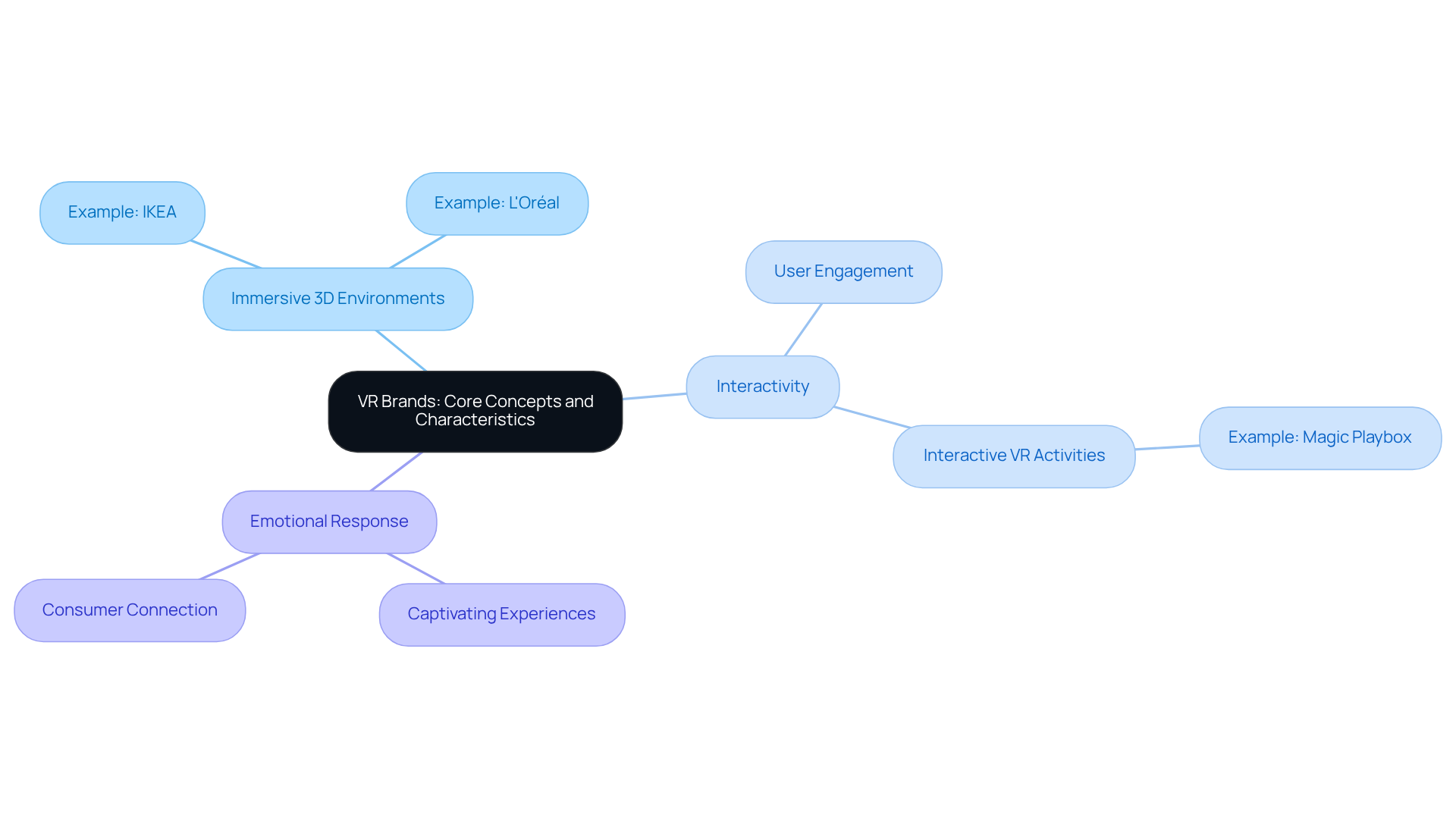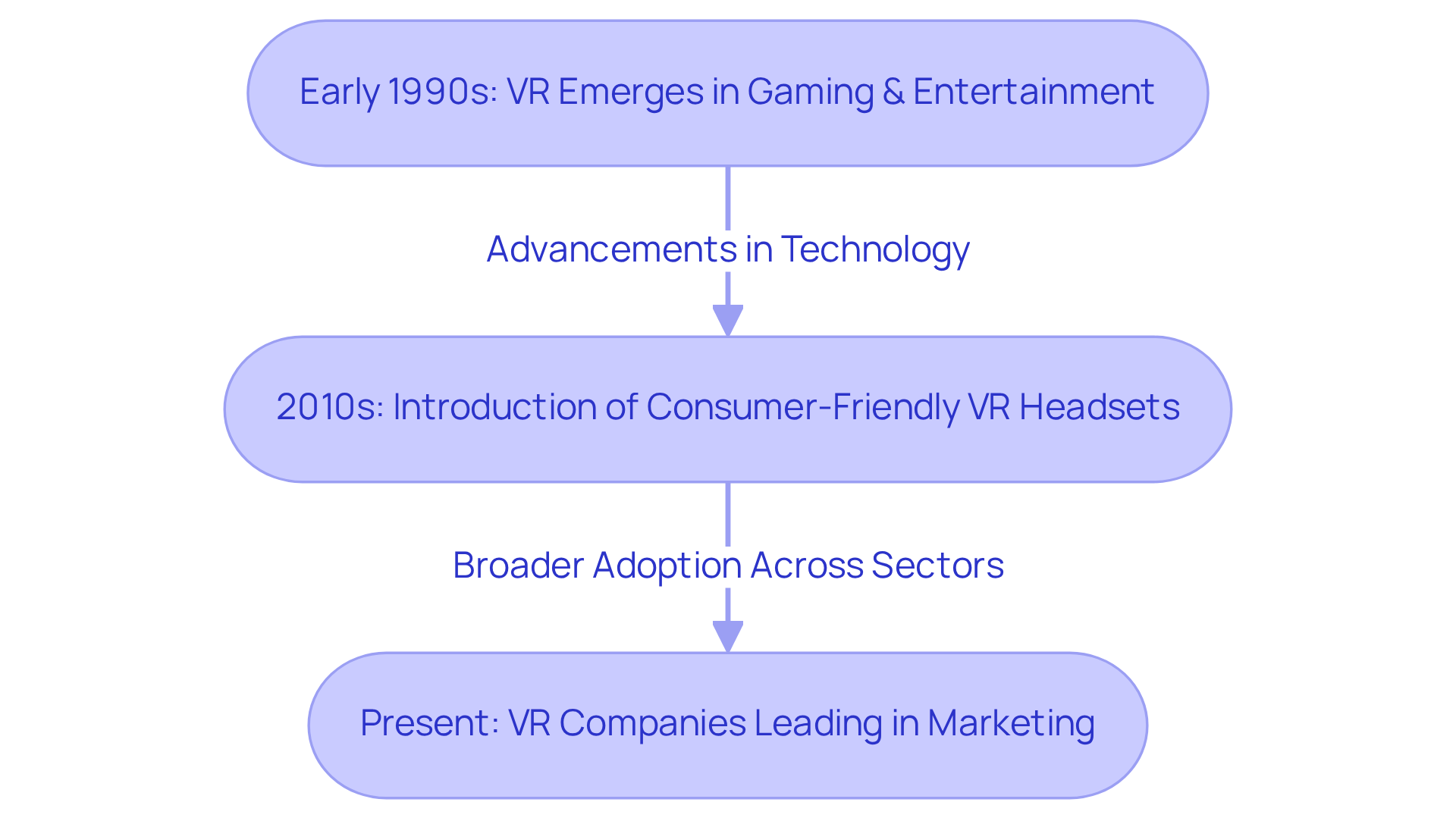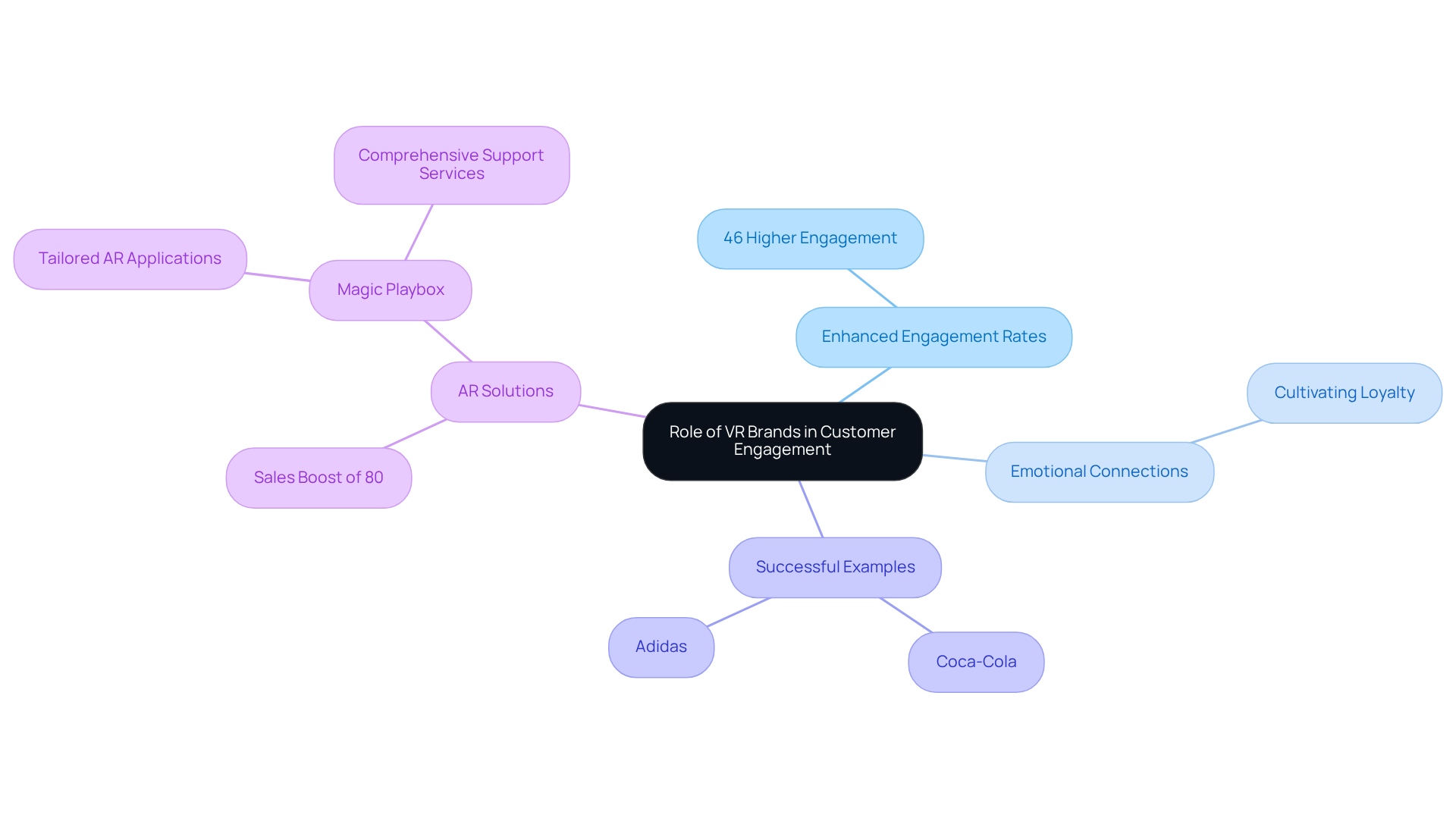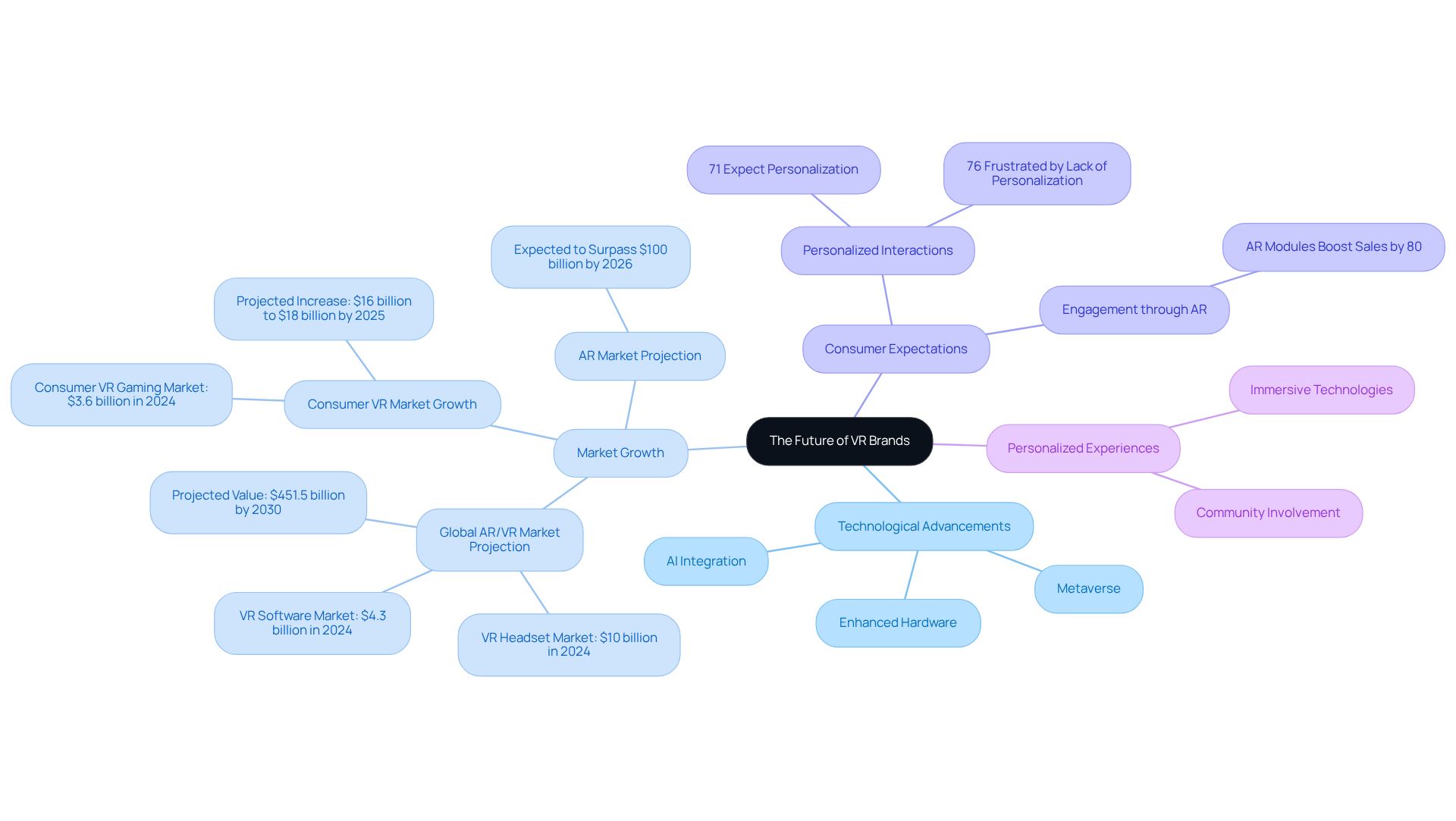Overview
This article provides a comprehensive exploration of the definition, evolution, and impact of VR brands, asserting their crucial role in crafting immersive and interactive marketing experiences that significantly enhance customer engagement.
Research indicates that VR technology has fundamentally transformed marketing strategies, with statistics revealing that VR experiences can boost engagement rates by 46% compared to traditional methods.
This substantial increase fosters deeper emotional connections between brands and consumers, underscoring the necessity for brand managers to embrace these proven strategies.
As the landscape of marketing evolves, the integration of VR technology is not merely an option but a strategic imperative for brands aiming to thrive in a competitive marketplace.
Introduction
VR brands are revolutionizing the marketing landscape by harnessing cutting-edge technology to create immersive experiences that captivate consumers in unprecedented ways. As these brands leverage virtual reality to enhance storytelling and interactivity, they not only engage users but also evoke emotional connections that traditional marketing methods struggle to achieve. Research indicates that emotional engagement significantly boosts brand loyalty.
However, as the VR market rapidly evolves, how can brands effectively navigate this dynamic environment to maximize customer engagement and loyalty?
Define VR Brands: Core Concepts and Characteristics
VR brands are leading the way in utilizing cutting-edge technology to create engaging encounters that attract consumers in unique ways. By leveraging VR, these organizations enhance storytelling, enabling users to interact with products and services within a simulated environment. Key characteristics of VR brands include:
- The use of immersive 3D environments
- Interactivity
- The capacity to evoke emotional responses through captivating experiences
For instance, leading VR brands such as IKEA and L'Oréal have successfully integrated VR into their marketing strategies, allowing customers to envision products in a virtual space before making a purchase. This innovative approach not only boosts user engagement but also cultivates a deeper connection between VR brands and their audience.
Research indicates that 48% of individuals in the U.S. have encountered VR, and with the global VR market projected to reach $50.3 billion by 2028, the strategic significance of these technologies in contemporary marketing is underscored. Furthermore, as VR headset ownership rises, with 80% of users operating their devices several times a month, the potential for VR to transform consumer interaction through immersive encounters becomes increasingly evident.
Magic Playbox exemplifies this by addressing the challenges companies face in captivating customers memorably through interactive VR activities.

Explore the Evolution of VR Brands in Marketing
The evolution of VR brands in marketing began in the early 1990s, when virtual reality emerged primarily as a concept linked to gaming and entertainment. As technology advanced, businesses recognized VR's potential to create engaging marketing environments.
The 2010s marked a pivotal turning point with the introduction of consumer-friendly VR headsets by companies like Oculus and HTC, facilitating broader adoption across various sectors.
Today, virtual reality companies lead the charge in creative marketing tactics, employing immersive interactions to capture customer interest and enhance participation. Notably, industry leaders such as Nike and Marriott have embraced VR to craft interactions that allow clients to explore products and services in a virtual setting, significantly enriching the overall customer journey.
This transformative shift is underscored by a 46% increase in audience engagement metrics compared to traditional formats, underscoring the effectiveness of VR in contemporary marketing.
As a brand manager, collaborating with VR brands can position your brand at the forefront of innovation, driving customer engagement and loyalty.

Examine the Role of VR Brands in Enhancing Customer Engagement
VR brands significantly enhance customer involvement by delivering immersive interactions that surpass conventional marketing techniques. These virtual environments empower users to engage with products in ways that cultivate enduring emotional connections. Research indicates that VR experiences can yield engagement rates that are 46% higher than traditional digital formats, underscoring the effectiveness of this technology in capturing audience attention. Notable companies, including Coca-Cola and Adidas, have successfully leveraged VR brands to create interactive campaigns that not only entertain but also stimulate customer participation. Such initiatives foster brand loyalty and drive increased sales, illustrating the profound impact of VR on consumer behavior and emotional responses in marketing. Furthermore, augmented reality (AR) solutions can boost sales by as much as 80%, showcasing the potential of immersive interactions to propel consumer action. Magic Playbox exemplifies this by providing tailored AR applications that enhance e-commerce interactions, ensuring businesses can effectively connect with their customers while benefiting from comprehensive support and maintenance services.

The Future of VR Brands: Trends and Innovations
The future of VR brands is poised for remarkable growth, driven by ongoing technological advancements that are reshaping the landscape. Innovations such as AI integration, enhanced hardware capabilities, and the emergence of the metaverse are expected to significantly elevate VR marketing strategies. Brands, particularly VR brands, will increasingly harness these developments to craft personalized and immersive experiences tailored to individual consumer preferences. Furthermore, the inclusion of social aspects within VR settings will foster community involvement, enabling companies to establish stronger ties with their audiences. As VR technology becomes more accessible and user-friendly, VR brands that adopt these innovations will likely secure a competitive advantage, driving greater adoption and engagement in the marketplace.
With the global AR/VR market projected to reach $451.5 billion by 2030, the potential for growth in this sector is substantial. Notably, 70% of businesses are expected to integrate AR/VR technologies by 2026. Additionally, the virtual reality headset market is anticipated to attain $10 billion in 2024, while the virtual reality software market size is predicted to reach $4.3 billion in the same year. This shift underscores the significance of early adoption and experimentation with engaging technologies from VR brands to enhance brand interactions and foster customer loyalty.
Significantly, 71% of buyers anticipate personalized interactions, and 76% express frustration when these expectations are unmet, highlighting the essential role of personalization in VR brands. Moreover, AR modules have been shown to boost sales by up to 80%, further emphasizing the effectiveness of immersive technologies in driving consumer engagement.

Conclusion
VR brands are a transformative force in the marketing landscape, harnessing immersive technology to create distinctive consumer experiences that foster deeper connections. By employing virtual reality, these brands not only enhance storytelling but also engage users in interactive environments that evoke emotional responses. This shift in engagement strategies underscores the critical role of VR in modern marketing, enabling brands to differentiate themselves in a crowded marketplace.
The evolution of VR brands has been remarkable since their inception, transitioning from gaming origins to becoming essential players in marketing strategies. Research indicates that immersive experiences can lead to a 46% increase in audience engagement compared to traditional marketing formats. Brands such as IKEA, L'Oréal, Nike, and Marriott exemplify this evolution, showcasing how VR can enrich customer interactions and drive loyalty. Furthermore, the projected growth of the VR market highlights the potential for ongoing innovation and adoption in the years ahead.
As the landscape of VR continues to expand, businesses must acknowledge the necessity of embracing these technologies to remain competitive. With consumers increasingly expecting personalized and immersive experiences, the integration of VR into marketing strategies is not merely an option but an imperative. By leveraging the power of VR, brands can enhance customer engagement and pave the way for future growth and success in an ever-evolving digital world.
Frequently Asked Questions
What are VR brands?
VR brands are organizations that utilize virtual reality technology to create engaging experiences that attract consumers in unique ways, enhancing storytelling and allowing users to interact with products and services in a simulated environment.
What are the key characteristics of VR brands?
Key characteristics of VR brands include the use of immersive 3D environments, interactivity, and the capacity to evoke emotional responses through captivating experiences.
Can you provide examples of companies that use VR in their marketing strategies?
Leading VR brands such as IKEA and L'Oréal have successfully integrated VR into their marketing strategies, allowing customers to envision products in a virtual space before making a purchase.
What benefits do VR brands offer to consumers?
VR brands boost user engagement and cultivate a deeper connection between the brand and its audience by providing immersive and interactive experiences.
How prevalent is VR usage among consumers?
Research indicates that 48% of individuals in the U.S. have encountered VR.
What is the projected growth of the global VR market?
The global VR market is projected to reach $50.3 billion by 2028.
How often do VR headset users operate their devices?
Approximately 80% of VR headset users operate their devices several times a month.
What challenges do companies face in engaging customers with VR?
Companies face challenges in captivating customers memorably through interactive VR activities, as exemplified by Magic Playbox, which addresses these challenges.




